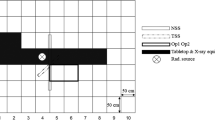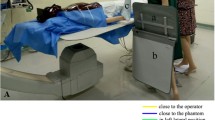Abstract
Purpose
Cardiac resynchronization therapy (CRT) often requires a long fluoroscopic time and protection from scatter radiation. This study reports on scatter radiation levels during CRT, with and without additional shielding, and using standard or low pulse rate fluoroscopy.
Materials and methods
Additional lead-shielding drape (0.35-mm lead equivalent) was used on the left side of the table and pulsed fluoroscopy was performed at rates of 10 pulses/s (usual rate) and 7.5 pulses/s (low pulse rate). Fluoroscopy scatter radiation was measured for both pulse rates using an acrylic phantom with a radiation survey meter, both with and without the additional lead-shielding drape.
Results
With the additional lead-shielding drape, the fluoroscopy scatter radiation was reduced by 74.3% at 10 pulses/s and 78.6% at 7.5 pulses/s. If the fluoroscopy was changed from 10 pulses/s to 7.5 pulses/s, the scattered radiation at the primary physician’s position was reduced by 24.0%. The combined use of additional shielding drape and low pulse rate fluoroscopy reduced scatter radiation by over 80%.
Conclusion
Additional lead-shielding drape and low pulse rate fluoroscopy are effective in reducing the scattered radiation dose to physicians and nurses during CRT.




Similar content being viewed by others
References
Wells G, Parkash R, Healey JS, Talajic M, Arnold JM, Sullivan S, et al. Cardiac resynchronization therapy: a meta-analysis of randomized controlled trials. CMAJ. 2011;183:421–9.
Haga Y, Chida K, Kaga Y, Sota M, Meguro T, Zuguchi M. Occupational eye dose in interventional cardiology procedures. Sci Rep. 2017;7:569.
Brambilla M, Occhetta E, Ronconi M, Plebani L, Carriero A, Marino P. Reducing operator radiation exposure during cardiac resynchronization therapy. Europace. 2010;12:1769–73.
Butter C, Schau T, Meyhoefer J, Neumann K, Minden HH, Engelhardt J. Radiation exposure of patient and physician during implantation and upgrade of cardiac resynchronization devices. Pacing Clin Electrophysiol. 2010;33:1003–12.
Vano E, Rosenstein M, Liniecki J, Rehani MM, Martin CJ, Vetter RJ, ICRP Publication 113. Education and training in radiological protection for diagnostic and interventional procedures. Ann ICRP. 2009;39:7–68.
Efstathopoulos EP, Pantos I, Andreou M, Gkatzis A, Carinou E, Koukorava C, et al. Occupational radiation doses to the extremities and the eyes in interventional radiology and cardiology procedures. Br J Radiol. 2011;84:70–7.
Thibault B, Andrade JG, Dubuc M, Talajic M, Guerra PG, Dyrda K, et al. Reducing radiation exposure during CRT implant procedures: early experience with a sensor-based navigation system. Pacing Clin Electrophysiol. 2015;38:63–70.
Chida K, Inaba Y, Saito H, Ishibashi T, Takahashi S, Kohzuki M, et al. Radiation dose of interventional radiology system using a flat-panel detector. AJR Am J Roentgenol. 2009;193:1680–5.
Chida K, Kaga Y, Haga Y, Kataoka N, Kumasaka E, Meguro T, et al. Occupational dose in interventional radiology procedures. AJR A J of Roentgenol. 2013;200:138–41.
Chida K, Kato M, Kagaya Y, Zuguchi M, Saito H, Ishibashi T, et al. Radiation dose and radiation protection for patients and physicians during interventional procedure. J Radiat Res. 2010;51:97–105.
Funama Y, Nagasue N, Awai K, Sakamoto I, Kakei K, Shimamura M, et al. Radiation exposure of operator performing interventional procedures using a flat panel angiography system: evaluation with photoluminescence glass dosimeters. Jpn J Radiol. 2010;28:423–9.
Heidbuchel H, Wittkampf FH, Vano E, Ernst S, Schilling R, Picano E, et al. Practical ways to reduce radiation dose for patients and staff during device implantations and electrophysiological procedures. Europace. 2014;16:946–64.
Valentin J. Avoidance of radiation injuries from medical interventional procedures. Ann ICRP. 2000;30:7–67.
Ertel A, Nadelson J, Shroff AR, Sweis R, Ferrera D, Vidovich MI. Radiation dose reduction during radial cardiac catheterization: evaluation of a dedicated radial angiography absorption shielding drape. ISRN Cardiol. 2012;2012:769167.
Abdelaal E, Plourde G, MacHaalany J, Arsenault J, Rimac G, Dery JP, et al. Effectiveness of low rate fluoroscopy at reducing operator and patient radiation dose during transradial coronary angiography and interventions. JACC Cardiovasc Interv. 2014;7:567–74.
Brambilla M, Cerini P, Lizio D, Vigna L, Carriero A, Fossaceca R. Cumulative radiation dose and radiation risk from medical imaging in patients subjected to endovascular aortic aneurysm repair. Radiol Med. 2015;120:563–70.
Malliet N, Andrade JG, Khairy P, Nguyen Thanh HK, Venier S, Dubuc M, et al. Impact of a Novel Catheter Tracking System on Radiation Exposure During the Procedural Phases of Atrial Fibrillation and Flutter Ablation. Pacing Clin Electrophysiol. 2015;38:784–90.
Chida K, Takahashi T, Ito D, Shimura H, Takeda K, Zuguchi M. Clarifying and visualizing sources of staff-received scattered radiation in interventional procedures. AJR Am J Roentgenol. 2011;197:W900–W903.
Sciahbasi A, Rigattieri S, Sarandrea A, Cera M, Di Russo C, Fedele S, et al. Determinants of operator radiation exposure during percutaneous coronary procedures. Am Heart J. 2017;187:10–8.
Chida K, Morishima Y, Katahira Y, Chiba H, Zuguchi M. Evaluation of additional lead shielding in protecting the physician from radiation during cardiac interventional procedures. Nihon Hoshasen Gijutsu Gakkai zasshi. 2005;61:1632–7.
van Dijk JD, Ottervanger JP, Delnoy PP, Lagerweij MC, Knollema S, Slump CH, et al. Impact of new X-ray technology on patient dose in pacemaker and implantable cardioverter defibrillator (ICD) implantations. J Interv Card Electrophysiol. 2017;48:105–10.
ICRP publication 103. The 2007 recommendations of the International Commission on Radiological Protection. Ann ICRP. 2007;37:1–332.
Morishima Y, Chida K, Katahira Y, Seto H, Chiba H, Tabayashi K. Need for radiation safety education for interventional cardiology staff, especially nurses. Acta Cardiol. 2016;71:151–5.
Inaba Y, Chida K, Kobayashi R, Kaga Y, Zuguchi M. Fundamental study of a real-time occupational dosimetry system for interventional radiology staff. J Radiol Prot. 2014;34:N65–N7.
Chida K, Morishima Y, Inaba Y, Taura M, Ebata A, Takeda K, et al. Physician-received scatter radiation with angiography systems used for interventional radiology: comparison among many X-ray systems. Radiat Prot Dosimetry. 2012;149:410–6.
Acknowledgements
We would like to acknowledge Koichi Tabayashi, MD, PhD Department of Cardiovascular Center, Tohoku Medical and Pharmaceutical University Hospital. We also thank Hiroo Chiba RT, Department of Radiology, Tohoku Medical and Pharmaceutical University Hospital, for technical assistance in this study. We thank Karl Embleton, PhD, from Edanz Group (www.edanzediting.com/ac) for editing a draft of this manuscript.
Author information
Authors and Affiliations
Corresponding author
Ethics declarations
Conflict of interest
The authors declare that they have no conflicts of interest.
Ethical statement
Not applicable.
About this article
Cite this article
Morishima, Y., Chida, K. & Katahira, Y. The effectiveness of additional lead-shielding drape and low pulse rate fluoroscopy in protecting staff from scatter radiation during cardiac resynchronization therapy (CRT). Jpn J Radiol 37, 95–101 (2019). https://doi.org/10.1007/s11604-018-0783-7
Received:
Accepted:
Published:
Issue Date:
DOI: https://doi.org/10.1007/s11604-018-0783-7




